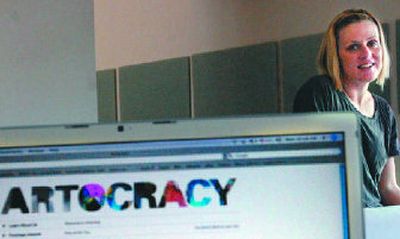ART GOES ONLINE

Megan Murphy has 83 artists from across the globe sharing their art work on her online gallery, Artocracy.org. The artists there are part of Murphy’s experiment. None of the artists is selling tangible art pieces; every work on “display” is a digital file, stored on a computer at Murphy’s Spokane County-based home office.
She sells about six works a month, ranging from $10 to $40 apiece. And she’s sure that a revised and upgraded Web page will spur sales to more than 20 per month.
Founded by Murphy in 2005, Artocracy is one example of visual artists testing the limits and opportunities available on the Internet.
She understands that many visual artists would never display their work in pure digital form. But Murphy — who earns a second income as an artist — still gets about 200 inquiries per month from people wanting to be included.
Murphy has selected about 850 works from visual artists who create pieces specifically for Artocracy. The pieces are not reproductions of paintings, prints or sculptures. Some of the works, however, are scanned original photos. Most of the artists use software tools like Corel Draw and Photoshop.
Artists who join Artocracy are typically also producing “regular” art for galleries.
The Artocracy option gives those artists an alternative way to explore and develop their style. “They can produce a body of digital prints that will help them work out ideas that later they’ll make into one-of-a-kind pieces,” Murphy said.
Buyers of work from Artocracy are doing something similar to people downloading music from iTunes. They pay for the work and can download the piece and then print out the PDF (Adobe Acrobat) version on a printer.
Or they can ask Murphy to print out the work — usually 8 by 10 inches — and send them the piece. She also offers framing.
Many artists use a personal Web page to develop a market presence. Many even sell on eBay to get their work to a wider public.
Others become involved in online galleries at a single Web site that serves as an umbrella service for dozens of artists. At a site like Ebsqart.com, hundreds of artists have created virtual galleries and take part in discussion forums that cover topics from finding quality materials to marketing.
Kettle Falls visual artist Gloria de los Santos has fully embraced the idea of selling some of her work at Artocracy, knowing she has to develop a wide range of outlets to reach buyers.
The one drawback of selling digital art, said de los Santos, is a perception by some buyers that a computer version isn’t original and may lack the value of a tangible work.
She creates works that are painted or altered photographs of plants and flowers and sells them on Artocracy. That form — a cyanotype — doesn’t involve intricate detail, she said.
“I choose images for Artocracy that have high contrast and limited details. Even if the quality of the printer is poor, the person downloading the art will still download a good image,” she said.
De los Santos has also found strong sales of her works on Ferry County’s Web cooperative shopthefrontier.com. She also markets herself through a personal MySpace page.
Artocracy isn’t profitable yet. Murphy takes a 25 percent commission on works sold there and adds a fee for printing and framing a sold work.
“I didn’t start it to make money,” said Murphy. “I did this to develop something that would be beneficial for artists.”
Some Artocracy artists have asked her to raise the price limit above $40 per piece.
“Some artists get angry at the idea of selling digital prints inexpensively. But they think about it and realize that not all of their work has to carry the weight of what they would show in a gallery,” she said.
Mead wildlife artist Linda Besse is among those who would not sell on Artocracy, citing the uncertain quality the works would have, depending on the quality of the printer used. She also prefers to create limited editions of her paintings or prints. By contrast, an Artocracy piece could have several thousand copies in circulation.
Besse has her own site, at www.besseart.com, and makes sure people find it by buying ads in some nationwide or specialized art magazines.
Originally she doubted the Web site would be more than a handy way to market her work. But people now find her site, see her work online and order pieces, some of them costing several thousand dollars.
That’s convinced her that the Web has changed the way artists find clients.
“Now the Web has definitely become a major part of my overall business strategy,” she said.